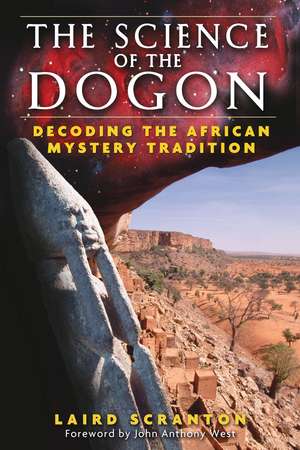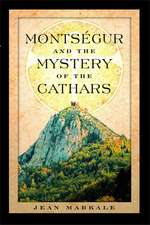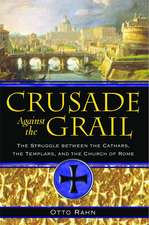The Science of the Dogon: Decoding the African Mystery Tradition
Autor Laird Scranton Cuvânt înainte de John Anthony Westen Limba Engleză Paperback – 21 sep 2006
Preț: 104.11 lei
Nou
Puncte Express: 156
Preț estimativ în valută:
19.92€ • 21.30$ • 16.61£
19.92€ • 21.30$ • 16.61£
Carte disponibilă
Livrare economică 27 martie-10 aprilie
Preluare comenzi: 021 569.72.76
Specificații
ISBN-13: 9781594771330
ISBN-10: 1594771332
Pagini: 224
Ilustrații: 17 b&w illustrations
Dimensiuni: 152 x 229 x 10 mm
Greutate: 0.31 kg
Editura: Inner Traditions/Bear & Company
Colecția Inner Traditions
Locul publicării:United States
ISBN-10: 1594771332
Pagini: 224
Ilustrații: 17 b&w illustrations
Dimensiuni: 152 x 229 x 10 mm
Greutate: 0.31 kg
Editura: Inner Traditions/Bear & Company
Colecția Inner Traditions
Locul publicării:United States
Notă biografică
Laird Scranton is an independent software designer who became interested in Dogon mythology and symbolism in the early 1990s. He has studied ancient myth, language, and cosmology for nearly 10 years and has been a lecturer at Colgate University. He also appears in John Anthony West’s Magical Egypt DVD series. He lives in Albany, New York.
Extras
from Chapter 6
Dogon Parallels to the Big Bang and Atomic and Quantum Structure
In the previous chapter, I demonstrated many superficial resemblances between the surface narrative of the Dogon creation story and the Big Bang theory of science. One of the primary functions of the surface storyline of the Dogon is to serve as a kind of mask for a more detailed body of knowledge contained within the deeper storyline. Therefore, if we are on the right track with our interpretation of Dogon symbols from the surface storyline, we should expect to find even more specific and recognizable details of the Big Bang theory incorporated into the deeper storyline of the Dogon creation story. When we carefully examine the elements of the deeper storyline, this is exactly what we find.
For the Dogon, the starting point for the deeper storyline is Amma’s egg--the unformed universe that contained all of the seeds or signs of the world. According to Dogon mythology, it was the opening of this egg that created all of the spiraling galaxies of stars and worlds. This concept of the origin of the universe conforms nicely to the prevailing theories of astrophysics, which define the unformed universe prior to the Big Bang as a kind of ball containing all of the potential matter of the future universe compressed to an unbelievably dense state. Accordingly, it was the rupturing of this ball that ultimately scattered matter as we now know it to the farthest reaches of the universe.
According to most astronomers, the “perfect unity that existed at the moment of the Big Bang”--science’s equivalent of Amma’s egg--represented a singularity, like what we now know as a black hole. Stephen Hawking describes the concept of a black hole in the following way in A Brief History of Time:
According to the theory of relativity, nothing can travel faster than light. Thus if light cannot escape, neither can anything else; everything is dragged back by the gravitational field. So one has . . . a region of space-time from which it is not possible to escape to reach a distant observer. . . . Its boundary is called the event horizon and coincides with the paths of light rays that just fail to escape from the black hole.
The diagram provided by Hawking to describe this event horizon--the path of the light rays that are unable to leave the black hole--is in most respects the very image of the Dogon stone representing Amma’s egg.
In many early mythologies, such as those of Hermopolis in Egypt and the Maori of New Zealand, the original creation of the universe is linked to the opening of an egg. The first entities to emerge after the moment of creation are the familiar triad of gods that we previously associated with the three physical states of water. Scientists believe that the plasma that emerged from the Big Bang was intensely hot and cooled rapidly to the near-zero temperature that we now see in the vacuum of space.
Astronomic theory explains that the first finished by-product of this cooling process after the Big Bang was the atom, and more specifically the hydrogen atom--the Dogon surface storyline’s counterpart to the Nummo. Again, if our understanding of the structure of the Dogon religion is correct, we would expect the deep creation storyline to include specific information about the atom and its constituent components, and again in fact it does.
For the Dogon, the po is the name of the “smallest grain” and represents one of the tiniest building blocks of the universe: the nucleus of an atom. Dogon descriptions of the po at the opening of Amma’s egg, forming like a central air bubble and scattering in a luminous motion, correlate well with scientific descriptions of the process of cooling of the quark-gluon plasma. When we suggest possible meanings for the Dogon symbols that are related to atomic structure, the idea is wholly and completely in keeping with how the Dogon understand their own symbols.
According to the Dogon, the po seed--already one of the most basic elements of creation--consists of four even more elemental components, referred to in combination as the sene seed. Marcel Griaule and Germaine Dieterlen say:
In this infinitely small thing [the sene] Amma then placed the four elements . . . The sene represents the first thing created by Amma . . . [Amma’s first act,] called “diagram of the sene seed,” connotes the superposition of the four elements in the formation of the seed . . . In accordance with Amma’s will, each of them extended its “germ” to touch its neighbor, from east to north, from north to west, etc. This “crossing of the germs” is compared to the intertwining of twigs forming a “nest,” senu. These germs then gathered at the center, where they mixed together and were transformed at the very site of the po, which was still invisible. Then, surrounding the seed, they made it visible . . .
This “crossing of the germs” in all directions is a very competent description aimed at a non-technical observer of the electrons in their crossing orbits surrounding an atom. These orbiting electrons, combined with their nucleus--the po--constitute a completed atom.
In The Pale Fox, Griaule and Dieterlen present a Dogon diagram of the sene seed that is a close match for typical scientific diagrams showing normal electron density and electron orbital shapes. Compare the scientific diagram reproduced below with the Dogon drawing beneath it.
Dogon Parallels to the Big Bang and Atomic and Quantum Structure
In the previous chapter, I demonstrated many superficial resemblances between the surface narrative of the Dogon creation story and the Big Bang theory of science. One of the primary functions of the surface storyline of the Dogon is to serve as a kind of mask for a more detailed body of knowledge contained within the deeper storyline. Therefore, if we are on the right track with our interpretation of Dogon symbols from the surface storyline, we should expect to find even more specific and recognizable details of the Big Bang theory incorporated into the deeper storyline of the Dogon creation story. When we carefully examine the elements of the deeper storyline, this is exactly what we find.
For the Dogon, the starting point for the deeper storyline is Amma’s egg--the unformed universe that contained all of the seeds or signs of the world. According to Dogon mythology, it was the opening of this egg that created all of the spiraling galaxies of stars and worlds. This concept of the origin of the universe conforms nicely to the prevailing theories of astrophysics, which define the unformed universe prior to the Big Bang as a kind of ball containing all of the potential matter of the future universe compressed to an unbelievably dense state. Accordingly, it was the rupturing of this ball that ultimately scattered matter as we now know it to the farthest reaches of the universe.
According to most astronomers, the “perfect unity that existed at the moment of the Big Bang”--science’s equivalent of Amma’s egg--represented a singularity, like what we now know as a black hole. Stephen Hawking describes the concept of a black hole in the following way in A Brief History of Time:
According to the theory of relativity, nothing can travel faster than light. Thus if light cannot escape, neither can anything else; everything is dragged back by the gravitational field. So one has . . . a region of space-time from which it is not possible to escape to reach a distant observer. . . . Its boundary is called the event horizon and coincides with the paths of light rays that just fail to escape from the black hole.
The diagram provided by Hawking to describe this event horizon--the path of the light rays that are unable to leave the black hole--is in most respects the very image of the Dogon stone representing Amma’s egg.
In many early mythologies, such as those of Hermopolis in Egypt and the Maori of New Zealand, the original creation of the universe is linked to the opening of an egg. The first entities to emerge after the moment of creation are the familiar triad of gods that we previously associated with the three physical states of water. Scientists believe that the plasma that emerged from the Big Bang was intensely hot and cooled rapidly to the near-zero temperature that we now see in the vacuum of space.
Astronomic theory explains that the first finished by-product of this cooling process after the Big Bang was the atom, and more specifically the hydrogen atom--the Dogon surface storyline’s counterpart to the Nummo. Again, if our understanding of the structure of the Dogon religion is correct, we would expect the deep creation storyline to include specific information about the atom and its constituent components, and again in fact it does.
For the Dogon, the po is the name of the “smallest grain” and represents one of the tiniest building blocks of the universe: the nucleus of an atom. Dogon descriptions of the po at the opening of Amma’s egg, forming like a central air bubble and scattering in a luminous motion, correlate well with scientific descriptions of the process of cooling of the quark-gluon plasma. When we suggest possible meanings for the Dogon symbols that are related to atomic structure, the idea is wholly and completely in keeping with how the Dogon understand their own symbols.
According to the Dogon, the po seed--already one of the most basic elements of creation--consists of four even more elemental components, referred to in combination as the sene seed. Marcel Griaule and Germaine Dieterlen say:
In this infinitely small thing [the sene] Amma then placed the four elements . . . The sene represents the first thing created by Amma . . . [Amma’s first act,] called “diagram of the sene seed,” connotes the superposition of the four elements in the formation of the seed . . . In accordance with Amma’s will, each of them extended its “germ” to touch its neighbor, from east to north, from north to west, etc. This “crossing of the germs” is compared to the intertwining of twigs forming a “nest,” senu. These germs then gathered at the center, where they mixed together and were transformed at the very site of the po, which was still invisible. Then, surrounding the seed, they made it visible . . .
This “crossing of the germs” in all directions is a very competent description aimed at a non-technical observer of the electrons in their crossing orbits surrounding an atom. These orbiting electrons, combined with their nucleus--the po--constitute a completed atom.
In The Pale Fox, Griaule and Dieterlen present a Dogon diagram of the sene seed that is a close match for typical scientific diagrams showing normal electron density and electron orbital shapes. Compare the scientific diagram reproduced below with the Dogon drawing beneath it.
Cuprins
Foreword by John Anthony West
Acknowledgments
Introduction
ONE How This Book Came to Be
TWO Themes of the Ancient Creation Stories
THREE The Dogon Creation Story
FOUR Dogon Symbols and Meanings
FIVE Dogon Parallels to the Big Bang and Atomic and Quantum Structure
SIX Dogon Parallels to String Theory
SEVEN Dogon Parallels to Egyptian Mythology
EIGHT Dogon Parallels to Genetics and Sexual Reproduction
NINE Archaeology and Dogon Symbols
TEN Judaism and Dogon Symbols
ELEVEN The Dogon Concept of Light
TWELVE Global Signs of the Serpent Religion
THIRTEEN Fall of the Serpent Religion
FOURTEEN Conclusion
Notes
Bibliography
Index
Acknowledgments
Introduction
ONE How This Book Came to Be
TWO Themes of the Ancient Creation Stories
THREE The Dogon Creation Story
FOUR Dogon Symbols and Meanings
FIVE Dogon Parallels to the Big Bang and Atomic and Quantum Structure
SIX Dogon Parallels to String Theory
SEVEN Dogon Parallels to Egyptian Mythology
EIGHT Dogon Parallels to Genetics and Sexual Reproduction
NINE Archaeology and Dogon Symbols
TEN Judaism and Dogon Symbols
ELEVEN The Dogon Concept of Light
TWELVE Global Signs of the Serpent Religion
THIRTEEN Fall of the Serpent Religion
FOURTEEN Conclusion
Notes
Bibliography
Index
Recenzii
“The Dogon creation myth reflects the nuances of cutting-edge scientific cosmology, and finally this is being recognized. A quintessential read for anyone wishing to learn the truth about this fascinating subject.”
“The Science of the Dogon decodes the opaque symbols of Dogon creation myth with great ingenuity backed by solid scholarship. Highly recommended.”
“The Science of the Dogon takes the study of the ancients to an exciting new level. Laird has cracked the visual code of the Dogon, and his explanations are thoroughly supported.”
". . . anyone who is remotely interested in our ancient past, ancient myths and traditions, and even how religion might enter into all this, will find Scranton's work intriguing."
"The author makes a convincing case for some intervening force in ancient times that left extremely important clues to their existence with the prevailing natives, knowing perhaps that someday someone would be aware of their presence."
"Enjoyable reading and a hands-on educational approach make this book very enjoyable. Readers will find the conclusion about the Dogon way exciting reading."
"The implications that are posited in Scranton's book are nothing short of earthshaking, considering that the Dogon appear to have gained these sophisticated insights through some sort of sixth sense.
" . . . The Science of the Dogon should prove to be a revolutionary force, especially with regard to integrating the Dogon cosmological vision into our own lives."
" . . . superb scholarly book, which gives overwhelming support to the O'Brien thesis of a single benevolent advanced source for civilization."
"Scranton is a lucid writer who articulates both scientific and cosmological concepts exceedingly well, and is transparent in his methodology. He amply demonstrates the skill set to perform such a demanding analysis, and I hope he continues further with his work."
“The whole text reveals striking similarities between Dogon symbols and those used in both the Egyptian and Hebrew religions, with amazing implications for the history of civilization. The material is an advance on the revelations that made Robert Temple’s The Sirius Mystery an international bestseller.”
“The Science of the Dogon decodes the opaque symbols of Dogon creation myth with great ingenuity backed by solid scholarship. Highly recommended.”
“The Science of the Dogon takes the study of the ancients to an exciting new level. Laird has cracked the visual code of the Dogon, and his explanations are thoroughly supported.”
". . . anyone who is remotely interested in our ancient past, ancient myths and traditions, and even how religion might enter into all this, will find Scranton's work intriguing."
"The author makes a convincing case for some intervening force in ancient times that left extremely important clues to their existence with the prevailing natives, knowing perhaps that someday someone would be aware of their presence."
"Enjoyable reading and a hands-on educational approach make this book very enjoyable. Readers will find the conclusion about the Dogon way exciting reading."
"The implications that are posited in Scranton's book are nothing short of earthshaking, considering that the Dogon appear to have gained these sophisticated insights through some sort of sixth sense.
" . . . The Science of the Dogon should prove to be a revolutionary force, especially with regard to integrating the Dogon cosmological vision into our own lives."
" . . . superb scholarly book, which gives overwhelming support to the O'Brien thesis of a single benevolent advanced source for civilization."
"Scranton is a lucid writer who articulates both scientific and cosmological concepts exceedingly well, and is transparent in his methodology. He amply demonstrates the skill set to perform such a demanding analysis, and I hope he continues further with his work."
“The whole text reveals striking similarities between Dogon symbols and those used in both the Egyptian and Hebrew religions, with amazing implications for the history of civilization. The material is an advance on the revelations that made Robert Temple’s The Sirius Mystery an international bestseller.”
Descriere
A look at the close resemblance between the creation and structure of matter in both Dogon mythology and modern science.


















